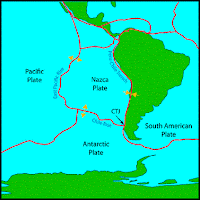 |
| Nazca, Pacific Plate relationship |
When someone claims to be providing facts on a topic, any topic, you expect the facts to be... accurate. As in his previous visit to the site, it appears that Hutchison attempted to share his notes from a long-ago introductory geology course and pretend they came from an authoritative source. Our staff geologist took a look and he says some of Cathel's pronouncements are pure bushwa (not the word he used). In other words, fractured factoids: sort of, but not quite, correct.
Geology guy listed a number of such fractures for your amusement, including:
- "When continental plates and oceanic plates move together along their boundaries..." – ...a strange what of saying "move toward one another." And how would they converge if not "along their boundaries"?
- "...the collision creates huge amounts of energy, releasing gigantic quaking tremors that cause deformation of the Earth’s crust. " – Ummm, no: those "gigantic quaking tremors" are pretty rare; most of the deformation is plastic (bending) instead of brittle (breaking).
- "Over millions of years, lava erupting along the boundary builds up on the ocean floor until a submarine volcano rises above sea level to become island volcanos, which become arranged in chains to form an island arc." – Here, Cathel ignored (or, more likely, was ignorant of) uplift along the overriding plate and thermal expansion of the crust.
- "Oceanic-continental plate boundaries are characterized by a mountain range, where the continental plate lifts up over the subducting oceanic plate, bordered by a deep subduction trench on the side of the oceanic trench." – Wait, a trench on the side of the trench? That's not to mention that Hutchison completely ignored volcanism related to melting of the subducted slab...
- "An example of an oceanic-continental plate boundary is the subduction of the Pacific plate below the Nazca plate on the west coast of the Americas, which formed the Andes mountains. " – No Cathel, the Nazca plate forms the eastern half of the Pacific basin in this region, and is subducting beneath the South American plate, causing the Andean orogeny. Dumbass. The boundary between the Nazca and Pacific plates is a divergent boundary, not a convergent boundary. Dumbass.
- "A current example of an oceanic-oceanic plate boundary is the Marianas Trench, which resulted from the Philippine Plate subducting under the Pacific Plate..." – You got that one backward, Cathel: the Pacific plate is subducting beneath the Mariana (Philippine) plate.
In other words, Hutchison fractured his tale by getting about half his factoids wrong... more than enough to earn himself another Dumbass of the Day award. Perhaps he should stick to liberal arts topics in the future if he can't read his class notes. Or perhaps he should stick to class notes in a subject where he got a passing grade...
¹ The original has been sent to the rewrite team by Leaf Group, but can still be accessed using the Wayback machine at archive.org. Its URL was http://www.ehow.com/info_8580692_convergent-boundaries.html
SI - TECTONICS
No comments:
Post a Comment